
- Erosão - O que é a erosão?
A Erosão é a destruição do solo e das rochas, o seu transporte em geral, é feito pela água da chuva, pelo vento ou, ainda, pela ação do gelo, quando expande o material no qual se infiltra a água congelada. A erosão destrói as estruturas que compõem o solo. Estas são transportados para as partes mais baixas dos relevos e em geral vão assorear cursos d'água. Em solos cobertos pela vegetação a erosão é muito pequena e quase inexistente, mas é um processo natural sempre presente e importante para a formação dos relevos. O problema ocorre quando o homem destrói as vegetações, para uso agrícola e deixa o solo exposto, porque a erosão torna-se severa, e pode levar a desertificação.
A superfície da Terra como a conhecemos é formada tanto por processos geológicos que formam as rochas, como por processos naturais da degradação e também de erosão. Uma vez que a rocha é quebrada por causa da degradação, os pequenos pedaços podem ser movidos pela água, gelo, vento, ou gravidade. Tudo o que acontece para fazer com que as rochas sejam transportadas chama-se erosão.
A superfície do solo, não castigado, é naturalmente coberta por uma camada de terra rica em nutrientes inorgânicos e materiais orgânicos que permitem o crescimento da vegetação; se essa camada é retirada, esses materiais desaparecem e o solo perde a propriedade de fazer crescer vegetação e pode-se dizer que, no caso, o terreno ficou árido ou que houve uma desertificação.
As águas da chuva quando arrastam o solo, quer ele seja rico em nutrientes e materiais orgânicos, quer ele seja árido, provocam o enchimento dos leitos dos rios e lagos com esses materiais e esse fenômeno de enchimento chama-se assoreamento. A erosão depende fundamentalmente da chuva, da infiltração da água, da topografia (declive mais acentuado ou não), do tipo de solo e da quantidade de vegetação existente. A chuva é, sem dúvida, a principal causa para que ocorra a erosão e é evidente que quanto maior a sua quantidade e frequência, mais irá influenciar o fenômeno. Se o terreno tem pouco declive, a água da chuva irá "correr" menos e erodir menos. Se o terreno tem muita vegetação, o impacto da chuva será atenuado porque a velocidade da água escorrendo no solo será diminuída devido aos obstáculos (a própria vegetação "em pé e caída") que agirão como pequenos degraus que evitam a erosão.
A erosão será diminuída também com as raízes darão sustentação mecânica ao solo; além disso, as raízes mortas propiciarão existirem canais para dentro do solo onde a água pode penetrar e com isso, sobrará menos água para correr na superfície. Outro fator importante é que, se as chuvas são frequentes e o terreno já está saturado de água, a tendência é que o solo nada mais absorva e com isso, toda a água da chuva que cair, correrá pela superfície. Se o solo for arenoso o arrastamento será maior do que se ele fosse argiloso.
- Tipos de Erosão -
Existem vários tipos de erosão, cada um com características que diferenciam uns dos outros, estando cada um ligado a uma causa especifica, num lugar especifico. Assim podemos nomear as seguintes causas de erosão:
- Erosão por gravidade -
Consiste no movimento de rochas e sedimentos montanha abaixo principalmente devido à força da gravidade.
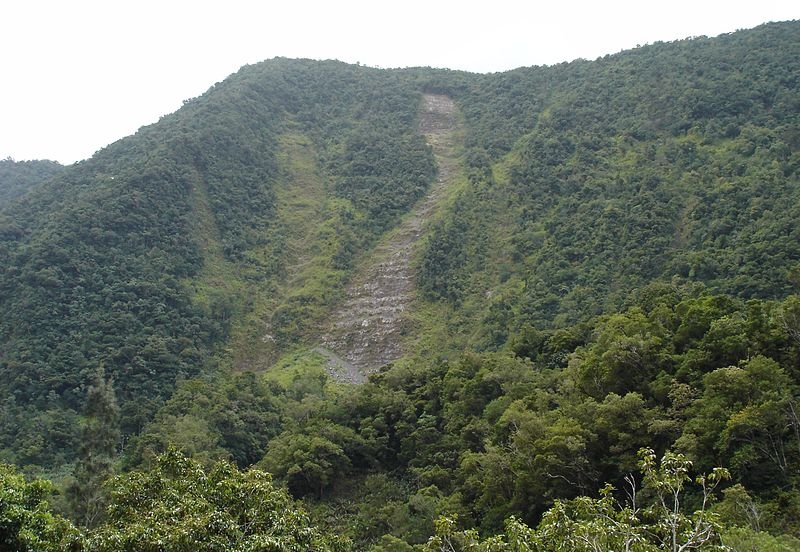 Este movimento origina o transporte gravítico de massas de solo, rochas, lama ou de outros materiais soltos ou não consolidados. As massas não são empurradas, primariamente, para baixo por intermédio de um agente erosivo, tal como a água corrente, o vento ou o gelo dos glaciares. Em vez disso, os movimentos de massa ocorrem quando a força da gravidade vence a resistência à deformação dos materiais do declive. Tais movimentos podem ser espoletados por sismos, inundações ou por outros eventos geológicos. Os materiais movem-se, então, declive abaixo, quer a uma velocidade baixa ou mesmo muito baixa, quer súbita e, na maior parte das vezes, catastroficamente. Podendo cair, deslizar ou fluir, os movimentos de massa podem deslocar pequenas, quase
Este movimento origina o transporte gravítico de massas de solo, rochas, lama ou de outros materiais soltos ou não consolidados. As massas não são empurradas, primariamente, para baixo por intermédio de um agente erosivo, tal como a água corrente, o vento ou o gelo dos glaciares. Em vez disso, os movimentos de massa ocorrem quando a força da gravidade vence a resistência à deformação dos materiais do declive. Tais movimentos podem ser espoletados por sismos, inundações ou por outros eventos geológicos. Os materiais movem-se, então, declive abaixo, quer a uma velocidade baixa ou mesmo muito baixa, quer súbita e, na maior parte das vezes, catastroficamente. Podendo cair, deslizar ou fluir, os movimentos de massa podem deslocar pequenas, quase 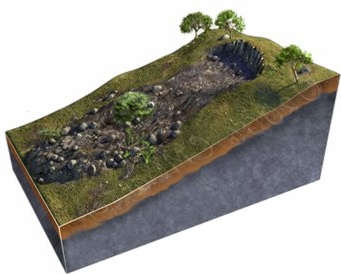 imperceptíveis, quantidades de solo ao longo de um declive fraco ou podem constituir enormes desprendimentos de terra que despejam toneladas de solo e rocha nos vales adjacentes às vertentes montanhosas abruptas.
imperceptíveis, quantidades de solo ao longo de um declive fraco ou podem constituir enormes desprendimentos de terra que despejam toneladas de solo e rocha nos vales adjacentes às vertentes montanhosas abruptas.
O desgaste de massa inclui, portanto, todos os processos pelos quais massas de rochas e de solo se movimentam vertente abaixo sob a influência da gravidade, sendo, eventualmente, transportado para outro local por agentes de transporte. O desgaste em massa é uma das consequências da meteorização e fragmentação das rochas. Constitui uma parte importante da erosão geral da paisagem, especialmente em regiões enrugadas ou montanhosas.
- Erosão Pluvial -
A erosão pluvial é provocada pela retirada de material da parte superficial do solo através das águas da chuva. Esta ação é acelerada quando a água encontra o solo desprotegido de vegetação. A primeira ação da chuva dá-se através do impacto das gotas d'água sobre o solo. Este é capaz de provocar a desagregação dos torrões e agregados do solo, lançando o material mais fino para cima e para longe, fenômeno conhecido como salpicamento. A força do impacto também força o material mais fino para abaixo da superfície, o que provoca a obstrução da porosidade do solo, aumentando o fluxo superficial e a erosão.
 A ação da erosão pluvial aumenta à medida que mais água da chuva se acumula no terreno, isto é, a retirada do solo se dá de cima para baixo. Na erosão remontante acontece exatamente o contrário: a retirada do material se dá de baixo para cima, como é o caso das boçorocas. Uma ravina de origem pluvial pode progredir em direção a uma boçoroca, mas não necessariamente. Da mesma forma podemos ter a progressão de boçorocas¹ independente da erosão pluvial, pois esta depende do fluxo subterrâneo e não do fluxo superficial.
A ação da erosão pluvial aumenta à medida que mais água da chuva se acumula no terreno, isto é, a retirada do solo se dá de cima para baixo. Na erosão remontante acontece exatamente o contrário: a retirada do material se dá de baixo para cima, como é o caso das boçorocas. Uma ravina de origem pluvial pode progredir em direção a uma boçoroca, mas não necessariamente. Da mesma forma podemos ter a progressão de boçorocas¹ independente da erosão pluvial, pois esta depende do fluxo subterrâneo e não do fluxo superficial.
As principais formas de erosão pluvial são:
a) erosão laminar: quando a água corre uniformemente pela superfície como um todo, transportando as partículas sem formar canais definidos. Apesar de ser uma forma mais amena de erosão, é responsável por grande prejuízo às terras agrícolas e por fornecer grande quantidade de sedimento que vai assorear rios, lagos e represas.
b) erosão em sulcos ou ravinas: quando a água se concentra em filetes, atingindo maior volume de fluxo e que podem transportar maior quantidade de partículas formando sulcos e ravinas na superfície. Estas ravinas podem chegar rapidamente a alguns metros de profundidade. É a forma extremamente perniciosa de erosão e tem que ser combatida rapidamente para evitar a total destruição de grandes superfícies de terras agrícolas. Também é responsável pelo rápido assoreamento das terras de várzea, dos leitos fluviais, lagos e represas, facilitando o transbordamento das águas de seus cursos e provocando inundações.
- Erosão Eólica -
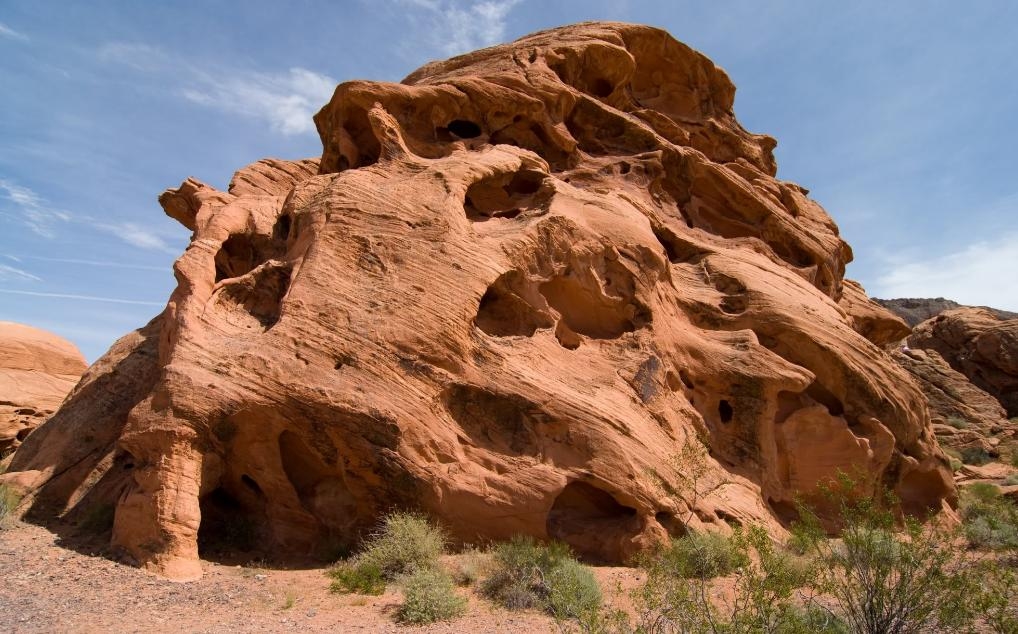 A Erosão eólica é um tipo de erosão causada pelo vento com a retirada superficial de fragmentos mais finos. A diminuição da velocidade do vento ou deflação ocorre freqüentemente em regiões de campos de dunas com a retirada preferencial de material superficial mais fino (areia, silte), permanecendo, muitas vezes, uma camada de pedregulhos e seixos atapetando a superfície erodida.
A Erosão eólica é um tipo de erosão causada pelo vento com a retirada superficial de fragmentos mais finos. A diminuição da velocidade do vento ou deflação ocorre freqüentemente em regiões de campos de dunas com a retirada preferencial de material superficial mais fino (areia, silte), permanecendo, muitas vezes, uma camada de pedregulhos e seixos atapetando a superfície erodida.
Pode ocorrer forte erosão associada à deflação, esculpindo nas rochas formas ruiniformes e outras feições típicas de deserto|regiões desérticas e outras assoladas por fortes ventos.
Em locais de forte e constante deflação podem se formar zonas rebaixadas, em meio a regiões desérticas, e que com as escassas chuvas formam lagos rasos (playa), secos na maior parte do tempo; lama endurecida ou camadas de sal atapetam, muitas vezes essas playas.
- Erosão Marinha -
A erosão marinha é um longo processo de atrito da água do mar com as rochas que acabam cedendo transformando-se em grãos, esse trabalho constante atua sobre o litoral transformando os relevos em planície e deve-se praticamente à ação de dois fatores presentes na termodinâmica : calor e frio, responsáveis pelo surgimento das ondas, correntes e marés .

Evolução e recuo de uma arriba pelo processo de erosão
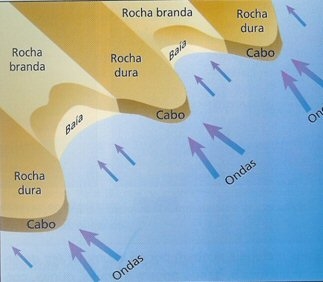 Tanto ocorre nas costas rochosas bem como nas praias arenosas. Nas primeiras a acção erosiva do mar forma as falésias, nas segundas ocorre o recuo da praia, onde o sedimento removido pelas ondas é transportado lateralmente pelas correntes de deriva litoral.
Tanto ocorre nas costas rochosas bem como nas praias arenosas. Nas primeiras a acção erosiva do mar forma as falésias, nas segundas ocorre o recuo da praia, onde o sedimento removido pelas ondas é transportado lateralmente pelas correntes de deriva litoral.
Nas praias arenosas a erosão constitui um grave problema para as populações costeiras. Os danos causados podem ir desde a destruição das habitações e infra-estruturas humanas, até a graves problemas ambientais. Para retardar ou solucionar o problema, podem ser tomadas diversas medidas de protecção, sendo as principais as construções pesadas de defesa costeira (enrocamentos e esporões) e a realimentação de praias.
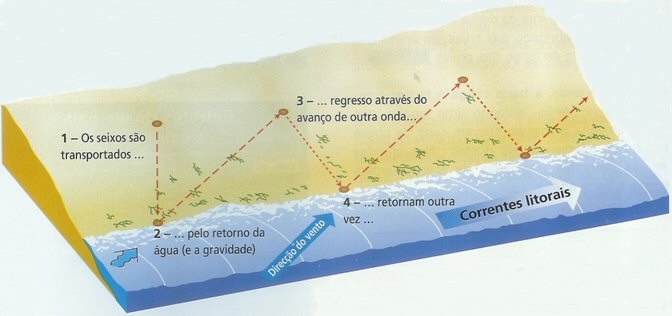
A erosão marinha tende a regular a linha de costa, desgastando as áreas mais salientes (cabos, arribas, etc.) e depositando materiais nas reentrâncias da costa, através dos processos de:
-
desgaste ou erosão das arribas pela força do embate das ondas
-
transporte, pelas correntes costeiras, dos materiais resultantes do processo de desgaste, que aumentam o poder da erosão marinha;
-
acumulação ou deposição dos materiais (areia, seixos...) arrastados pela força das ondas e transportados pelas correntes.
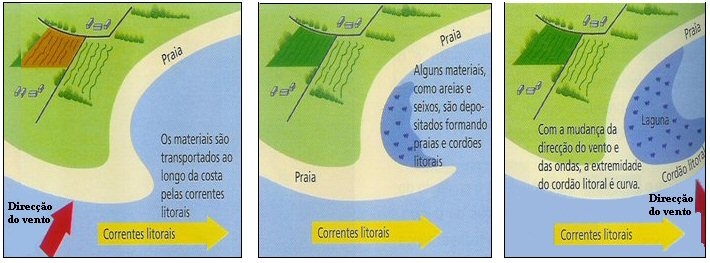
A acção de desgaste está condicionada pelos seguintes factores:
a) reacções químicas entre a água e os materiais;
b) acção mecânica da água;
c) força e direcção das ondas;
d) natureza das rochas - dureza, constituição química e coesão.
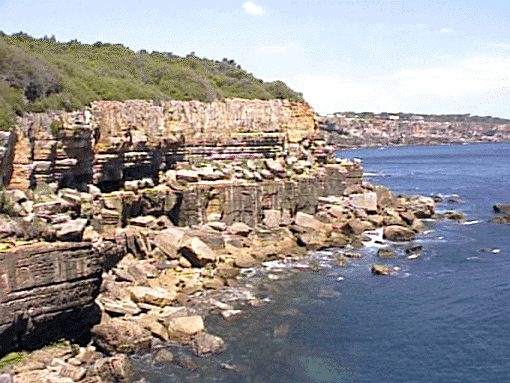 O desgaste origina materiais soltos, de dimensões muito variáveis que as correntes marítimas transportam, por vezes, a grandes distâncias. Quando a velocidade e força das correntes diminuem os materiais transportados são depositados ou acumulados.
O desgaste origina materiais soltos, de dimensões muito variáveis que as correntes marítimas transportam, por vezes, a grandes distâncias. Quando a velocidade e força das correntes diminuem os materiais transportados são depositados ou acumulados.
As correntes marítimas transportam materiais resultantes do desgaste da costa ou trazidos pelos cursos de água ( rios que desaguam no litoral) que depositam quando a velocidade das águas diminui devido à baixa profundidade.
- Erosão Química -
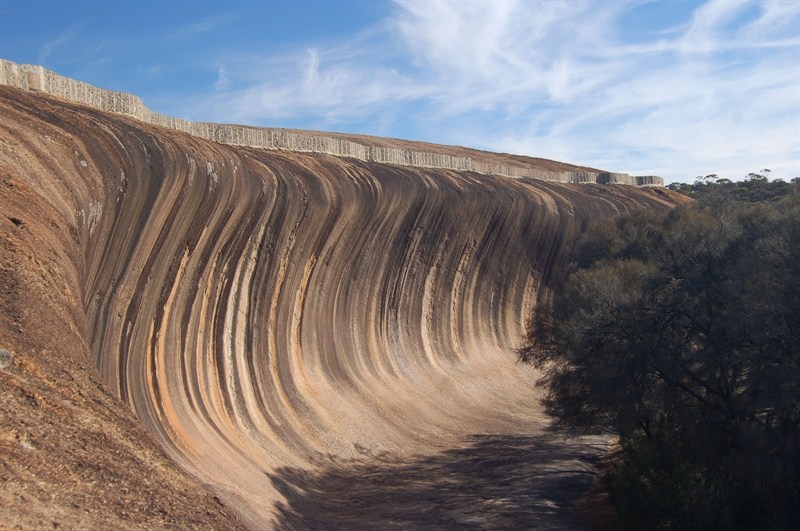 A erosão química envolve todos os processos químicos que ocorrem nas rochas. Há intervenção de fatores como calor, frio, água, compostos biológicos e reações químicas da água nas rochas. Este tipo de erosão depende do clima, em climas polares e secos, as rochas se destroem pela troca de temperatura; e em climas tropicais quentes e temperados, a humidade, a água e os dejetos orgânicos reagem com as rochas e as destroem.
A erosão química envolve todos os processos químicos que ocorrem nas rochas. Há intervenção de fatores como calor, frio, água, compostos biológicos e reações químicas da água nas rochas. Este tipo de erosão depende do clima, em climas polares e secos, as rochas se destroem pela troca de temperatura; e em climas tropicais quentes e temperados, a humidade, a água e os dejetos orgânicos reagem com as rochas e as destroem.
- Erosão Glacial -
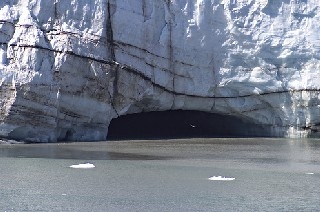 Os glaciares deslocam-se lentamente, no sentido descendente, provocando erosão e sedimentação glacial. Ao longo dos anos, o gelo pode desaparecer das geleiras, deixando um vale em forma de U ou um fiorde, se junto ao mar.
Os glaciares deslocam-se lentamente, no sentido descendente, provocando erosão e sedimentação glacial. Ao longo dos anos, o gelo pode desaparecer das geleiras, deixando um vale em forma de U ou um fiorde, se junto ao mar.
A erosão glacial pode também ocorrer devido à susceptibilidade das glaciações em locais com predominância de rochas porosas. No verão, a água acumula-se nas cavidades dessas rochas. No inverno, essa água congela e sofre dilatação, pressionando as paredes dos poros. Terminado o inverno, o gelo funde, e congela novamente no inverno seguinte. Esse processo ocorrendo sucessivamente, desagregará, aos poucos, a rocha, após um certo tempo, causando o desmoronamento de parte da rocha, e consequentemente, levando à formação dos grandes paredões ou fiordes.
- Erosão Fluvial -
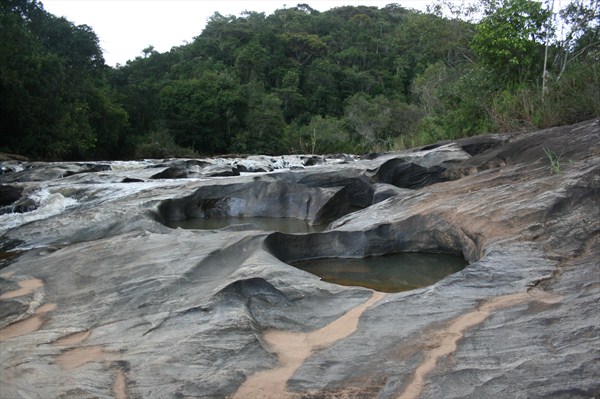 Erosão fluvial é o desgaste do leito e das margens dos rios pelas suas águas. Este processo pode levar a alterações no curso do rio. O relevo resultante da sedimentação das rochas no processo de erosão é denominado Colúvio. A erosão das rochas pode gerar ravinas, voçorocas e deslizamentos de terra, no qual estes sedimentos são escoados para as partes mais baixas, formando colúvios e depósitos de encosta.
Erosão fluvial é o desgaste do leito e das margens dos rios pelas suas águas. Este processo pode levar a alterações no curso do rio. O relevo resultante da sedimentação das rochas no processo de erosão é denominado Colúvio. A erosão das rochas pode gerar ravinas, voçorocas e deslizamentos de terra, no qual estes sedimentos são escoados para as partes mais baixas, formando colúvios e depósitos de encosta.
Podemos observar, também que a fase do rio é determinante para a erosão causada por tal. Assim, na fase inicial da erosão, devido a grande declividade do terreno, pode acontecer com mais intensidade, na fase mais avançada acontece transporte de sedimentos, ja na fase final ocorre o processo de acumulação de tais sedimentos.
¹ Boçorocas - A boçoroca, voçoroca ou ravina é um fenômeno geológico que consiste na formação de grandes buracos de erosão, causados pela chuva e intempéries, em solos onde a vegetação é escassa e não mais protege o solo, que fica cascalhento e suscetível de carregamento por enxurradas. Pobre, seco e quimicamente morto, nada fecunda. São causadas pelo intemperismo físico da ação pluvial e são considerados ações erosivas. Os sedimentos decorrentes dessas ações climáticas são deslocados para as partes mais baixas e ali depositados. Formam-se assim os colúvios e depósitos de encosta, caracterizando o processo de sedimentação.
O termo "voçoroca" tem origem no termo tupi ibysoroka, que significa "rasgo de terra", de yby ("terra") e soroka ("rasgo").
Esta Earthcache situa-se numa praia desconhecida por muitos na Serra da Arrábida, num pequeno recanto que encontra-se muito afectado pela erosão. Aqui irão ter de identificar os varios factores e responder as perguntas para poderem fazer o log desta earthcache. Tenham cuidado no acesso à praia, muito provavelmente vão ter de se molhar no caso de irem a pé. A praia só é acessivel na maré baixa, especialmente em marés grandes, onde aqui já se pode ir a pé sem nos molharmos depois de destreparmos das pedras. Estejam sempre com muita atenção por onde andam e não vão à chuva ou de noite.
_________________________________________________________________________________
Para registar a sua visita nesta cache precisa enviar-me um e-mail com as resposta às seguintes perguntas:
1 - Nas coordenadas da earthcache (na praia), quantas e quais formas de erosão podemos visualizar e onde?
2 - Ainda na praia, quantas grutas pequenas que foram formadas através da erosão, com mais de 1 metro, podemos visualizar?
3 - O waypoint indicado mostra um local causado pela erosão, que deslocou uma pedra que se encontra dentro de àgua. Qual a largura média que vai desde essa pedra até à arriba?
4 - Explique por palavras suas, o que eventualmente irá acontecer aquele local, graças à erosão.
5 - Apesar de ser opcional, uma foto no local da earthcache será sempre bem vinda.

- Erosion - What is erosion?
Erosion is the destruction of soil and rocks, the transport is usually done by rain, wind, or even by the action of ice, when you expand the material on which infiltrates the frozen water. Erosion destroys the structures that make up the ground. These are transported to the lower parts of the reliefs and generally will assorear waterways. In soils covered by vegetation, erosion is very small and almost non-existent, but it is a natural process always present and important for the formation of the reliefs. The problem occurs when man destroys the vegetation for agricultural use and leaves the soil exposed, because the erosion becomes severe and can lead to desertification.
The surface of the Earth as we know it is formed both by geological processes that form rocks such as by natural processes of weathering and erosion also. Once the rock is broken by the degradation, the small pieces can be moved by water, ice, wind, or gravity. Everything that happens to cause rocks to be carried away is called erosion.
The surface of the soil, not punished, is naturally covered by a layer of soil rich in inorganic nutrients and organic materials that allow vegetation growth if this layer is removed, these materials disappear and the soil loses the property to grow vegetation and can say that, in case the ground was dry or that there was a desertification.
The rainwater when dragging the ground, whether it is rich in nutrients and organic materials, whether it be dry, causing the filling of the beds of rivers and lakes from these materials and filling this phenomenon is called sedimentation. Erosion is crucially dependent on rain water infiltration, topography (steeper slope or not), soil type and amount of existing vegetation. Rain is undoubtedly the main cause for erosion to occur and it is evident that the greater the quantity and frequency, the more it will influence the phenomenon. If the ground has little slope, rainwater will "run" erode less and less. If the land has a lot of vegetation, the impact of rain will be mitigated because the speed of running water in the soil will be diminished because of the obstacles (vegetation itself "standing and fallen") who will act as small steps to prevent erosion.
Erosion is also reduced with the roots give mechanical support to the ground, in addition, the dead roots will provide channels to exist within the soil where water can penetrate and thus, less water will be left to run on the surface. Another important factor is that if the rains are frequent and the ground is already saturated with water, the tendency is that the soil absorbs and nothing more about it, all the rainwater that falls, run over the surface. If the soil is sandy the drag will be greater than if it were clay.
- Types of Erosion -
There are several types of erosion, each with characteristics that differ from one another and are each linked to a specific cause in a specific place. So we can name the following causes of erosion:
- Gravity Erosion -
It consists in the movement of rocks and sediment down the mountain mainly due to gravity.
 This movement causes the gravitational mass transport of soil, rocks, mud or other loose or unconsolidated materials. The masses are not pushed primarily down by an agent of erosion, such as water, wind or ice glaciers. Instead, the mass movements occur when gravity overcomes resistance to deformation of slope materials. Such movements can be triggered by earthquakes, floods or other geological events. The materials move, then down a slope or at a low speed or very low both sudden and in most cases, catastrophically. Can fall, slip or flow, mass movements can displace small, almost imperceptible amounts of soil over a slope can be weak or large detachments of land that dump tons of soil and rock in the valleys adjacent to steep mountain slopes.
This movement causes the gravitational mass transport of soil, rocks, mud or other loose or unconsolidated materials. The masses are not pushed primarily down by an agent of erosion, such as water, wind or ice glaciers. Instead, the mass movements occur when gravity overcomes resistance to deformation of slope materials. Such movements can be triggered by earthquakes, floods or other geological events. The materials move, then down a slope or at a low speed or very low both sudden and in most cases, catastrophically. Can fall, slip or flow, mass movements can displace small, almost imperceptible amounts of soil over a slope can be weak or large detachments of land that dump tons of soil and rock in the valleys adjacent to steep mountain slopes.
The wear mass therefore includes all processes by which masses of rock and soil move down slope under the influence of gravity, and eventually transported to another place by carriers. The wear mass is a consequence of fragmentation and weathering of rocks. It is an important part of the general erosion of the landscape, especially in rugged or mountainous regions.
- Rain Erosion -
The rain erosion is caused by the removal of material from the superficial part of the soil by rainwater. This action is accelerated when the soil water is unprotected by vegetation. The first action the rain comes about through the impact of water drops on the ground. This can cause breakdown of the soil and soil aggregates, casting the thinnest material up and away, a phenomenon known as splash. The force of impact also forces the finer material to below the surface, which causes the obstruction of the soil porosity, increasing the flow and surface erosion.
 The action of rain erosion increases as more rain water accumulates on the ground, ie, the removal of the soil occurs from the top down. Headward erosion in the opposite happens: the removal of material occurs from the bottom up, as is the case of boçorocas. A source ravine rain can progress toward a boçoroca, but not necessarily. Likewise we can be independent of boçorocas progression of erosion from rainfall, as this depends on groundwater flow and no surface flow.
The action of rain erosion increases as more rain water accumulates on the ground, ie, the removal of the soil occurs from the top down. Headward erosion in the opposite happens: the removal of material occurs from the bottom up, as is the case of boçorocas. A source ravine rain can progress toward a boçoroca, but not necessarily. Likewise we can be independent of boçorocas progression of erosion from rainfall, as this depends on groundwater flow and no surface flow.
The main forms of erosion from rainfall are:
a) laminar erosion, when the water flows evenly across the surface as a whole, transporting the particles without forming channels defined. Despite being a milder form of erosion, is responsible for great damage to agricultural land and provide large amounts of sediment that will assorear rivers, lakes and reservoirs.
b) erosion rills or gullies, when water is concentrated in fillets, reaching higher volume and flow that may carry greater number of particles forming ridges and ravines on the surface. These gullies can quickly reach several feet deep. It is extremely pernicious erosion and must be tackled quickly to avoid total destruction of large areas of farmland. It is also responsible for the rapid sedimentation of floodplain lands, beds of rivers, lakes and reservoirs, facilitating the outflow of water from their courses and flooding.
- Wind Erosion -
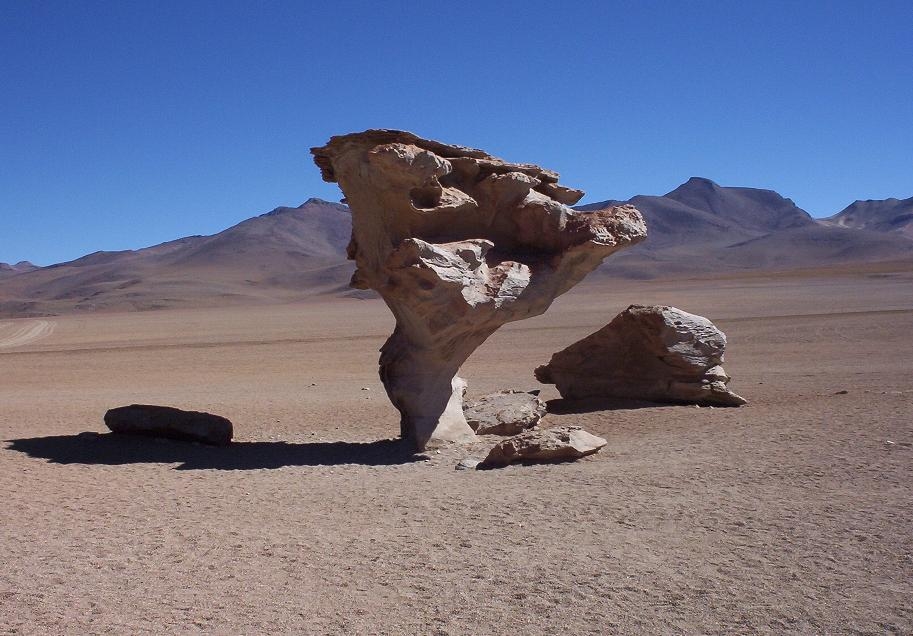 Wind erosion is a type of wind erosion by removing surface debris thinner. The decrease in wind speed or deflation occurs frequently in areas of dune fields with preferential removal of material finer surface (sand, silt) and was often a layer of gravel and pebbles eroded surface of the carpeting.
Wind erosion is a type of wind erosion by removing surface debris thinner. The decrease in wind speed or deflation occurs frequently in areas of dune fields with preferential removal of material finer surface (sand, silt) and was often a layer of gravel and pebbles eroded surface of the carpeting.
There may be severe erosion associated with deflation, carving rocks ruiniform forms and other features typical of desert and other desert regions plagued by strong winds.
In places with strong and steady deflation can form recessed areas in the middle of the desert regions, and that with the scarce rains form shallow lakes (playa), dry most of the time, caked mud or salt layers of carpet, often these playas.
- Shoreline Erosion -
The Shoreline erosion is a long process of attrition of seawater with the rocks that end up turning into yielding grains, that acts on the constant work transforming the coastal plain and in relief must be practically the action of two factors in thermodynamic : heat and cold, responsible for the appearance of waves, currents and tides.
Both occur on the rocky shores and sandy beaches. In the first the erosive action of the sea as the cliffs, on the second is the retreat of the beach, where the sediment was removed by the waves is transported laterally by littoral drift currents.
In the sandy beaches from erosion is a serious problem for coastal populations. The damage can range from the destruction of housing and human infrastructure, to the serious environmental problems. To slow down or solve the problem, can be taken several measures of protection, and the main buildings of heavy coastal defense (rockfill and spurs) and beach nourishment.
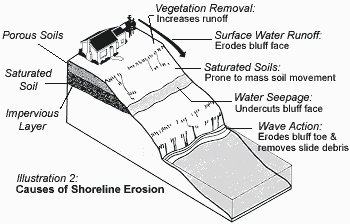 The marine erosion tends to regulate the shoreline, eroding the areas most salient (cables, cliffs, etc.)., And depositing material in the recesses of the coast, through the processes of:
The marine erosion tends to regulate the shoreline, eroding the areas most salient (cables, cliffs, etc.)., And depositing material in the recesses of the coast, through the processes of:
- wear or erosion of the cliffs by the force of the shock wave
- transport by coastal currents, materials resulting from the weathering process, which increases the power of marine erosion;
- accumulation or deposition of materials (sand, pebbles ...) dragged by the force of waves and transported by currents.
The action of attrition is conditioned by the following factors:
a) chemical reactions between water and materials;
b) mechanical action of water;
c) strength and direction of the waves;
d) nature of the rocks - hardness, chemical composition and cohesion.
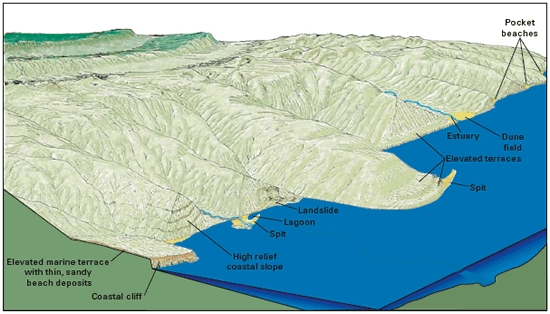
Wear loose materials originates, of very variable sea currents carry it sometimes over great distances. When the speed and strength of the currents decrease the transported materials are deposited or accumulated.
The sea currents carry materials resulting from the erosion of the coast or brought in by rivers (rivers that flow into the coast) who place when the velocity of water decreases due to the low depth.
- Chemical Erosion -
The chemical erosion involves all the chemical processes occurring in the rock. There is involvement of factors such as heat, cold, water, organic compounds and chemical reactions of water on the rocks. This type of erosion depends on climate, polar climates and dry and the rocks are destroyed by changing temperature, and in tropical and warm temperate, humidity, water and organic waste react with the rocks and destroy them.
- Glacial Erosion -
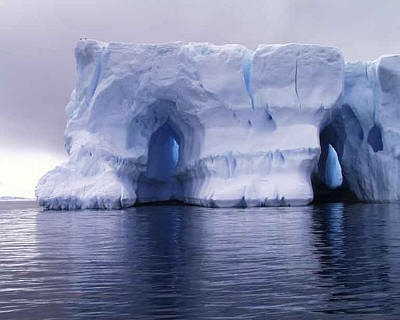 The Glaciers move slowly downward, causing glacial erosion and sedimentation. Over the years, the ice of the glaciers may disappear, leaving a U-shaped valley or fjord to the sea.
The Glaciers move slowly downward, causing glacial erosion and sedimentation. Over the years, the ice of the glaciers may disappear, leaving a U-shaped valley or fjord to the sea.
Glacial erosion can also occur due to the susceptibility of the glaciations in areas with a predominance of porous rocks. In summer, water accumulates in the cavities of these rocks. In winter, this water freezes and suffers dilatation, pressing the pore walls. After the winter, the ice melts and freezes again the following winter. This process occurs successively break down slowly, the rock, after a certain time, causing the collapse of part of the rock, and consequently leading to the formation of large walls or fjords.
- Fluvial Erosion -
Fluvial erosion is the erosion of the bed and banks of rivers from their water. This process can lead to changes in the course of the river. The relief resulting from the sedimentation of the rocks in the erosion process is called colluvium. The erosion of rocks can generate ravines, gullies and landslides, in which these sediments are discharged to the lower parts, forming deposits of colluvium and slope.
We can see also that the phase of the river is crucial to the erosion caused by such. Thus, in the initial phase of erosion due to steep slopes of the terrain, can occur with more intensity, more advanced stage happens in sediment transport, already occurs in the final stage the process of accumulation of such sediments.

This EarthCache is located on a beach unknown by many in the Serra da Arrábida, in a small corner that is greatly affected by erosion. Here you'll need to identify the various factors and answer the questions to be able to log this EarthCache. Beware the beach access, most likely you will have to get wet in the case of going on foot. The best time is right on low tide, where here you can already walk, almost twithout getting wet. Always be very carefully where to go and not going to rain or at night.
_________________________________________________________________________________
To register your visit to this earthcache, you need to send me an email with the answers to the following questions:
1 - On the beach, how many forms and what forms of erosion can you see and where can you see them?
2 - While on the beach, how many small caves that were formed through the process of erosion can you see, with more than 1 meter?
3 - The waypoint shown, indicates a site caused by erosion, which displaced a stone that lies within water. What is the approximate width that ranges from the rock to the cliff?
4 - Explain in your own words, what will eventually happen to that place, thanks to erosion.
5 - Although optional, a picture of you on the earthcache location is always welcome.
